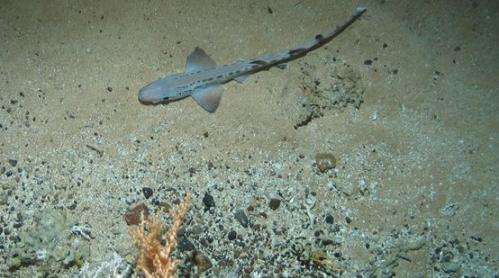Deep-sea shark nursery found in Outer Hebrides coral reef

(Phys.org) —Marine biologists from Heriot-Watt have discovered a deep-sea shark spawning ground on Scotland's only inshore coral reef.
The team discovered egg cases of the blackmouth catshark, Galeus melastomus, on the Mingulay Reef complex, a seascape of cold-water coral reefs in the Outer Hebrides.
Deepwater sharks have long been a draw for recreational anglers in the region, but this is the first time their spawning grounds have been found in Scotland. The Mingulay Reef is awaiting designation as a marine protected area (MPA) from the European Union, which the Heriot-Watt scientists say is essential to help safeguard local sharks and the millions of pounds generated by recreational anglers who visit Scotland in the hope of catching one.
Dr Lea-Anne Henry from Heriot-Watt University explained, "It's very exciting to find these spawning sites, as there's still relatively little information about deep-sea sharks habitat across their life cycles. Our research at Mingulay and in even deeper Scottish waters is now revealing many close links between cold-water corals and the early life stages of sharks, skates and rays.
"Protecting these spawning sites has real economic benefits too. Over 60 percent of sport anglers target catsharks when they fish this area, which brings in over £140 million to the Scottish economy each year. Sports anglers catch the sharks and release them back in the water, which helps us document and ultimately conserve the populations.
"Sharks aren't just part of this underwater ecosystem, they're a huge part of the local and national economy. We also spotted another species prized by anglers, the lesser-spotted catshark Scyliorhinus canicula, using the reef, and there is also a nursery site for the critically endangered spurdog Squalis acanthias very close by."
A remotely operated vehicle (ROV) was used to survey the living cold-water corals of the Mingulay Reef during Heriot-Watt's Changing Ocean Expedition in 2012. The team discovered not only that the blackmouth catshark spawns there, but that it has some particular requirements for a spawning habitat.
Shark eggs were always found 'nested' in corals at a narrow depth range (165-172 metres) on sites that are slightly sloped and colonised by highly rugose (rough) corals. In addition, the spawning sites were all located on the leeward side of the reefs, which protects them from being blown away by strong currents.
Dr Henry explained, "Catsharks are known to spawn on vertical structures in other waters but this is the first time we've found proof of a nursery in Mingulay.
"The sharks are choosing these sites because they're safe. The corals have lots of hard branches, which deter predators and laying them away from the current in lower parts of the seabed reduces the risk of eggs drifting away.
"The height of the coral means the eggs receive plenty of air and that they're not suffocated by sediments and debris."
The Mingulay Reef Complex was designated as a proposed MPA in 2010, but its status is still to be determined.
Provided by Heriot-Watt University
















